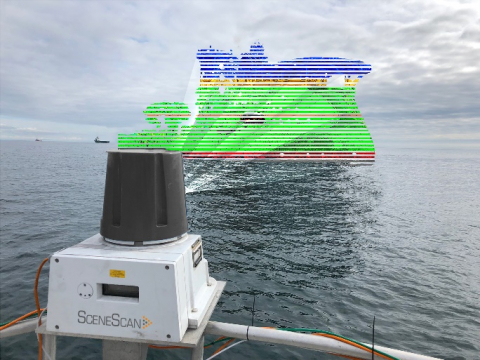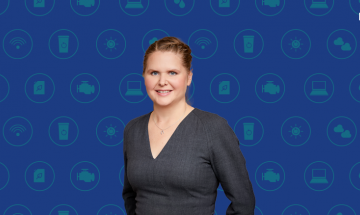
Dynamic Positioning is becoming increasingly dynamic
Text and photos originally published by Wärtsilä
Wärtsilä is an established leader in the development and delivery of Dynamic Positioning (DP) systems and the specialised sensors used by these systems. The Wärtsilä DP group has a lineage dating back to the 1960s, and the sensor group has an almost 20-year history of delivering sensors to the offshore industry.
We sat down for a chat with Dr Sasha Heriot, Business Development Manager, and Michael Ford, GM Global Sales DP and SmartMove Systems, Wärtsilä Voyage, to discuss how dynamic a system should be in order to keep a vessel at a fix position and heading.
Let’s start with the technology landscape. What is a DP system capable of, in particular?
SH: The core capability of a DP system is the closed loop controller. This is designed to handle the mundane task of maintaining the vessel’s position and heading for long periods for applications such as holding station while drilling, offloading supplies, or supporting diver operations. It is also used for following Remotely Operated Vehicles (ROVs) when performing pipeline inspections. It is important to understand that while a human can perform these tasks, the availability of an automated system dramatically increases the repeatability and consistency of the task and reduces the workload of the crew, allowing them to focus more on the operational aspects of the job.
What are the applications for DP in shipping?
MF: The cruise industry, for example, directly benefits from tools simplifying vessel manoeuvres during low-speed port operations, thus enhancing the capability of the Captain. In this case the DP controller is used to take care of one or two axes of movement (surge, sway, or heading) while manual control of the remaining axis can be reduced to a single control handle – the joystick. This simplifies operations such as docking, where the controller can hold heading and the fore-aft position, while the joystick can be used to drive the vessel laterally towards the dock. Similarly, with a vessel rotation operation within a turning basin, the controller can hold the vessel on station while the joystick is used to control the rotation.
SH: Wärtsilä’s SmartDrive product can also simplify the operation of other difficult to control vessels, by reducing the impact of higher clutch in levers and numerous thrusters, to a single easy to use coordinated control joystick.
In a more radical development, the closed loop controller has been applied to automated vessel operations, resulting in a new product, Wärtsilä SmartDock. Tracks and waypoints are used to provide instructions to the controller, which can then undock a vessel, transit it to a new area of interest, and subsequently guide the vessel to the next docking situation, all without input from the Captain. The SmartDock controller takes care of vessel manoeuvres enabling the Captain to use more time monitoring any ongoing situations surrounding the vessel. Particularly in ferry services, the Captain is relieved of the repetitive task of frequent transits and dockings, resulting in increased safety and more consistent operation of the vessel, potentially even reducing fuel consumption.
Is there an integration capability for the data volumes to be reconciled into a coherent picture?
MF: While the initial SmartDock product relies on a library of routes for the Captain to select from, it has evolved to accept track segments from other products. Especially during wind farm operations, an operator may want to create a track of opportunity using a charting system, then transfer the track to the controller. SmartDock also integrates with automated route planners, thereby allowing more advanced navigation and the advancement of more autonomous operations using external situational awareness and collision avoidance systems.
More information on Wärtsilä SmartMove Suite
SH: With manoeuvring systems like SmartDock evolving from DP roots, the sensors systems requirements have also made many leaps forward. The Wärtsilä sensor group has for many years developed both optical and Radio Frequency (RF) based sensors to provide relative positional data. While these sensors have seen great success in the offshore industry, they too are now being applied for new applications. The most notable evolution is SceneScan – effectively a Light Detection and Ranging (LIDAR) type product, which has evolved from the laser and prismatic target-based CyScan product.
What value does this new product bring for DP systems?
SH: When launched in 2018, Wärtsilä’s SceneScan represented a major breakthrough, and a paradigm shift from conventional DP reference sensors. SceneScan is the world’s first laser-based targetless relative DP reference sensor and is capable of working without the need for pre-placed positioning targets. Not only does this add significantly greater operational flexibility and deliver a higher level of safety, it also reduces costs by eliminating the need for reflector targets. In 2019, SceneScan received type approval from the DNV GL classification society. Interestingly, the type approval tests were carried out onboard an LNG bunker vessel, highlighting the fact that DP is used effectively in an increasingly broad range of maritime applications.
Know more about the SceneScan System
Is it possible to extend SceneScan’s functionality beyond traditional DP systems?
SH: Indeed. While the earlier mentioned SmartDock product greatly relies on the Global Navigation Satellite System (GNSS) as a position reference, there are situations, such as berthing areas or travelling under bridges, where the GNSS antennas may be masked by structures. For these instances SceneScan can conveniently be used as a secondary position sensor, supplying data to the SmartDock system.
MF: There’s also Wärtsilä’s SceneScan Monopole Tracking that is specially designed for use on wind farm Service Operational Vessels (SOVs). The system has been developed to enable the sensor to look for its target (the monopole) at approximately 200 metres, and then to continue tracking it throughout the whole operation and whilst transferring people to and from the wind turbine. This represents a considerable improvement in safety levels for operations within the wind farm.
In the maritime world news tends to spread quickly, and when something special comes along there is usually broad interest among owners and operators in looking at how it can affect or influence their business. For this reason, Wärtsilä is actively carrying out sea trials to demonstrate the radical difference delivered by SmartDock and SceneScan compared to conventional systems, and to firmly establish that they deliver features that are needed and asked for.
Read the original article here





